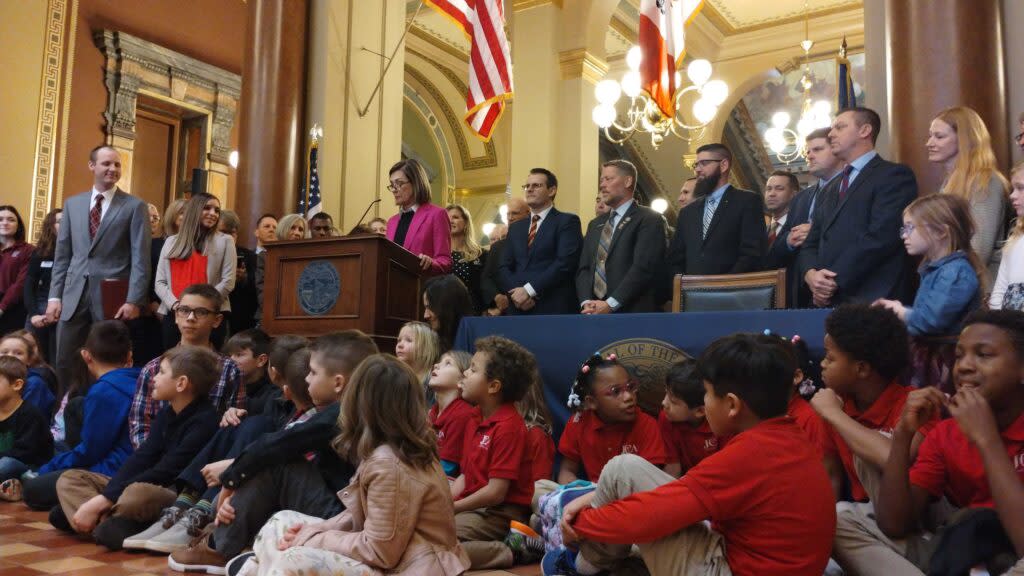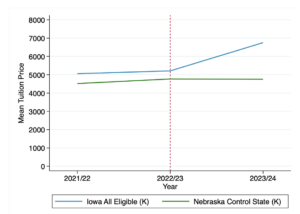Study links state ESA program to spike in Iowa K-12 private school tuition

- Oops!Something went wrong.Please try again later.
Gov. Kim Reynolds, surrounded by lawmakers and school children, speaks in the Capitol rotunda before signing her private-school scholarship legislation Jan. 24, 2023. (Photo by Robin Opsahl/Iowa Capital Dispatch)
A study published by Brown and Princeton universities shows that kindergarten tuition at Iowa private schools went up by between 21% and 24% since the implementation of the state’s Education Savings Account program.
The ESA program, signed into law by Gov. Kim Reynolds in early 2023, allows families to create an account for their K-12 student to pay for private school tuition and associated costs. ESA accounts for the 2023-2024 school year were $7,635 — equal to the per-pupil funding total received by public K-12 schools — and will increase to $7,826 for the 2024-2025 school year.
However, these funds are not yet available to all students. For the first year of implementation, the current school year, all kindergarteners, Iowa public school students and private school students with a family income of 300% or below the federal poverty line were eligible for the program. In the upcoming year, the income eligibility limit will expand to 400% the FPL before having no income limit beginning in the 2025-26 school year onward.
The program, spearheaded by Reynolds and voted for by a majority of Republican lawmakers, was discussed by supporters as a means to ensure Iowa students of different economic backgrounds have equal access to the schooling that best suits their academic needs.
But in the study, researchers Jason Fontana and Jennifer Jennings found that private school tuition increased significantly in Iowa following the implementation of the ESA program, while private school tuition in Nebraska, which passed a similar program into law in 2023 that will not be implemented until the 2024-25 school year, did not see the same increase.
In Iowa, tuition for students in grades 1 through 12, where not all families are yet eligible for ESAs, increased by between 10% and 16%, the study found. The average increase in cost was $1,280 for kindergarten tuition and $830 for higher grades when accounting for fixed effects, according to the research.
In an Iowa Press interview, Senate President Amy Sinclair — a major proponent of the program — said that while the private school tuition costs have increased, “most of the non-public schools are still below the cost per pupil that public schools are spending on a student.”
She also said there are other economic factors, like recent inflation, that have pushed Iowa K-12 private schools to raise tuition for reasons other than the public funds being available.
“That is pretty telling in that we are facing an inflation crisis,” Sinclair said. “I think those tuition increases would have occurred regardless of an education savings account scholarship when you have, over the course of the last three years, cumulative inflation of about 20%. Those costs impact non-public schools. I would suggest to you that regardless of the study, those tuition increases would have had to have occurred.”
As inflation rises, costs of schooling are going up, she said, meaning that private schools need more funding for costs like teacher salaries, food and school supplies.
Reynolds has also previously stated that she is not concerned about private schools increasing tuition due to the ESA program, as Iowa private schools are facing the same issues with funding and teacher shortages as public schools, and that tuition increases are a means to help alleviate those problems.
However, the researchers in the study concluded that higher tuition was directly linked to the ESA program, comparing Iowa’s increase in costs during the program’s first year of implementation to the growth in previous years. Additionally, the study compared Iowa’s jump in mean private school tuition with Nebraska — where the state’s ESA program has not yet taken effect — which saw between 3% to 5% increased tuition costs at the state’s private schools.
Using this data, the researchers argued that the ESA program is not meeting its intended goal of making private schools more accessible for lower-income Iowans.
“To the extent tuition levels outpace the ESA payment, families unable to further contribute to tuition may be priced out of schools, thus defeating the program’s stated goal,” the paper states. “If this is the case, ESAs act as tuition subsidies for families who can already afford private school. Future work should consider to what extent tuition increases limit families’ options.”
Sinclair said she was not worried about lower-income students being priced out of private schools due to the ESA program, as many private schools offer scholarships to students in addition to ESA funds. She also criticized the study as “very, very flawed” for not including data from all of Iowa’s private schools. The study said that data from 51% of Iowa’s private schools was used in the final analysis.
“The study itself was so grossly flawed as to not even be a topic of conversation for me,” Sinclair said. “Yes, there have been tuition increases. We have also increased funding to our public schools because 20% inflation over three years is going to be detrimental to any system that has to buy supplies and pay people. It’s just a reality of what this economic crisis that we have been facing as a nation under the Biden administration brings us.”
The increase in per-pupil state aid for public schools that the Legislature approved for next year was 2.5%.
Democrats have argued that the ESA program is providing government funding to private schools to the detriment of Iowa’s public K-12 system. When a student enrolls in a private school using the ESA program, the public school district loses its “per-pupil” funding through State Supplemental Aid for that child. However, the program does provide school districts with roughly $1,200 for each student living in the district attending a private school.
House Minority Leader Jennifer Konfrst criticized the program’s high cost earlier in May — in its first year, ESAs cost the state $107.4 million. The Legislative Services Agency estimated in 2023 that the program will cost $132.3 million in fiscal year 2024, $294.7 million in 2025 and $344.9 million in 2026.
“We’re going to see hundreds of millions of dollars spent on this, a billion dollars over five years is not unreasonable,” Konfrst said. “And in a state like Iowa, that is simply not sustainable, especially when we remember that that money is coming. That money could be going to public schools to make it better for everyone — 54% of the vouchers so far have gone to 10 counties. So, how is this helping rural Iowa? But the budget for public education has been reduced statewide. So, it’s simply not a fair system.”
The post Study links state ESA program to spike in Iowa K-12 private school tuition appeared first on Iowa Capital Dispatch.


